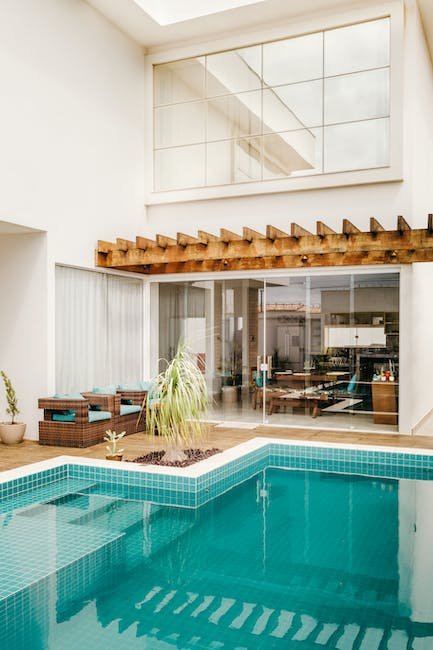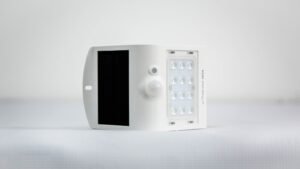Prepare to be schooled on one of pickleball’s most fascinating phenomenon: the non-volley zone, also known as the no-fly zone. Nestled cunningly between the opposing teams’ side, this patch of sacred territory is revered as the ultimate stronghold of strategic prowess. With a mystical power to dictate the flow of any match, the non-volley zone is a force to be reckoned with, demanding both respect and understanding. In this article, we shall unravel the enigma of this remarkable domain, exploring its purpose, rules, and the pivotal role it plays in the dynamic game of pickleball. So take a deep breath, tighten your grip on that paddle, and delve into the intricate world of the non-volley zone – where no ball shall fly without proper permission.
Table of Contents
- The Non-Volley Zone: A Crucial Area on the Pickleball Court
- Unveiling the Rules and Boundaries of the Non-Volley Zone
- Mastering the Art of Properly Executing Shots in the Non-Volley Zone
- Key Strategies to Dominate the Non-Volley Zone in Pickleball
- Tips and Drills to Improve Your Non-Volley Zone Play
- Q&A
- The Conclusion

The Non-Volley Zone: A Crucial Area on the Pickleball Court
Pickleball enthusiasts know that the non-volley zone, often referred to as the “kitchen,” is undoubtedly one of the most critical areas on the court. Positioned strategically near the net, this zone holds immense significance and adds an extra layer of excitement to the game.
1. Understanding the Non-Volley Zone:
The non-volley zone extends seven feet on either side of the net and is marked by a distinctive line. It directly surrounds the net, preventing players from stepping into this zone and hitting a volley while being close to the net. This rule ensures fair play and promotes a thrilling blend of strategy, patience, and quick reflexes.
2. Why is the Non-Volley Zone Crucial?
The non-volley zone forces players to momentarily step back from the net, adding an extra challenge to their shots. It promotes strategic placement and encourages players to master the art of the dink, a gentle and controlled shot near the net. Shots played from this area require precision and finesse, allowing players to tactically outmaneuver their opponents.
3. Mastering the Non-Volley Zone:
Players who can effectively utilize the non-volley zone gain a competitive edge. Skilled players tactfully execute dinks, drop shots, and lobs from this area, putting their opponents on the defensive. Developing patience and footwork skills is key to successful play in the kitchen, as it demands quick reactions and controlled movements.

Unveiling the Rules and Boundaries of the Non-Volley Zone
Welcome to the world of pickleball, where precision and strategy take center stage. In this post, we are excited to dive deep into the rules and boundaries of the Non-Volley Zone, also known as the “Kitchen.” It is a uniquely defined area on the pickleball court that poses exciting challenges and sets the stage for thrilling rallies.
The Basic Rules:
-
Players must not volley the ball while standing inside the Non-Volley Zone. A volley occurs when a player hits the ball in mid-air, without allowing it to bounce.
-
Once the ball bounces outside of the Non-Volley Zone, players are free to volley.
-
It’s crucial to note that even if a player’s foot touches any part of the Non-Volley Zone line during a volley, it results in a fault.
Boundary Lines:
-
The Non-Volley Zone is marked using a distinct 7-foot area on both sides of the net. These areas extend from the net to the sideline and are parallel to the net.
-
The Non-Volley Zone is always in effect, regardless of where the ball is during play. Players need to remain cautious and observe the boundaries diligently.
So, whether you’re a seasoned pickleball player or a newbie looking to understand the intricacies of the game, understanding and respecting the rules and boundaries of the Non-Volley Zone will undoubtedly enhance your gameplay. So step up to the line, strategize your shots, and let the exhilarating rallies begin!
Mastering the Art of Properly Executing Shots in the Non-Volley Zone
When it comes to pickleball, the non-volley zone, also known as the kitchen, is a critical part of the game. In order to dominate the kitchen and score points, understanding how to execute shots with finesse and precision is essential. Here are a few strategies and tips to help you master the art of properly executing shots in the non-volley zone.
- Placement is key: Instead of going for power, focus on placing your shots strategically. Aim for the corners or to the side of your opponents, making it difficult for them to return the ball effectively. By varying your shots’ placement, you can keep your opponents guessing and off balance.
- Master the dinks: The dink, a soft shot that barely clears the net, is a crucial shot to master in the non-volley zone. Use a gentle paddle angle and minimal swing motion to finesse the ball over the net. The goal is not to overpower your opponent but rather to create unpredictable placement and force them into a weaker position.
- Be patient and wait for your opportunity: Rushing shots in the non-volley zone can lead to mistakes and lost points. Practice patience and wait for the right moment to strike. Anticipate your opponent’s moves and be ready to react with a well-executed shot when the opportunity arises.
By honing these techniques and dedicating time to practice, you can elevate your game and gain a competitive edge in the non-volley zone. Remember, it’s not just about power but about finesse, precision, and creating opportunities. So, step onto the pickleball court, embrace the challenge, and let your shot execution skills shine!
Key Strategies to Dominate the Non-Volley Zone in Pickleball
When it comes to pickleball, mastering the non-volley zone can truly take your game to the next level. This area, also known as the kitchen, is a crucial battleground where players must navigate their shots with precision and strategy. Here are some key strategies that can help you dominate the non-volley zone:
- Footwork is the Foundation: In order to control the non-volley zone effectively, footwork is paramount. Remain light on your feet, always ready to move quickly and adjust your position. Stay balanced, and be prepared to shuffle forward, backward, and side to side to cover the entire kitchen area.
- Master the Soft Game: The non-volley zone is not the place for aggressive shots. Instead, focus on perfecting your soft game, including dinks and drop shots. These gentle shots allow you to place the ball precisely and create opportunities for your opponent to make mistakes.
- Use the Lob Wisely: Intelligently implementing a lob can be a game-changer in the non-volley zone. When your opponent is relentlessly pressuring you, a well-executed lob can buy you time to regain control of the point. Use it sparingly and strategically, catching your opponent off guard and forcing them to retreat from the non-volley zone.
By applying these key strategies, you’ll become a force to be reckoned with in the non-volley zone. Remember, practice makes perfect, so hit the courts and incorporate these techniques into your game. Soon enough, you’ll be dominating the kitchen and outmaneuvering your opponents with finesse!
Tips and Drills to Improve Your Non-Volley Zone Play
Mastering the non-volley zone, also known as the kitchen, is crucial for any successful pickleball player. It’s the no-volley zone where players can’t hit the ball out of the air (unless it has bounced) and being able to strategically position yourself in this area can greatly enhance your game. Here are some tips and drills to help you improve your non-volley zone play:
- Find your footwork rhythm: Proper positioning is key when it comes to non-volley zone play. Focus on your footwork and finding a rhythm that allows you to quickly move in and out of the kitchen. Practice shuffling your feet and maintaining a balanced stance at all times.
- Soften your touch: The delicate nature of the non-volley zone requires a gentle touch. Instead of overpowering your shots, aim to hit softer, controlled shots that stay low and close to the net. This will help you maintain control and minimize the risk of hitting the ball into the net or out of bounds.
- Drills for precision: To enhance your accuracy within the non-volley zone, practice drills that focus on placement. Set up targets or use a tape to mark specific areas on the court and aim to consistently hit shots within those zones. This will improve your ability to strategically place shots where your opponents are at a disadvantage.
Remember, consistency and patience are key when working on your non-volley zone play. By incorporating these tips and drills into your practice routine, you’ll be well on your way to becoming a formidable force at the kitchen line!
Q&A
What is the Non-Volley Zone in pickleball?
The Non-Volley Zone, also known as the “kitchen,” is a seven-foot area surrounding the net where players are not allowed to hit the ball out of the air. This rule exists to prevent players from dominating the game with powerful smashes.
Why is it called the “No-Fly Zone”?
The Non-Volley Zone is often referred to as the “No-Fly Zone” because players cannot hit the ball in the air while standing within this designated area. They must let it bounce before they can return it, adding an additional challenge to the game.
What happens if a player steps into the Non-Volley Zone?
If a player steps into the Non-Volley Zone while volleying the ball, their shot is considered a fault, and they lose the point. Stepping into this forbidden zone requires careful footwork and quick reflexes to avoid costly mistakes.
When can players enter the Non-Volley Zone?
Players can enter the Non-Volley Zone at any time, as long as they do not volley the ball. They are allowed to step into this area after the ball has bounced in the receiving team’s side, allowing for a groundstroke return.
Are there any exceptions to the Non-Volley Zone rule?
Yes, there are a few exceptions to the Non-Volley Zone rule. If the ball bounces inside the Non-Volley Zone, players may still hit it in the air as long as they do not step into the zone while doing so. Additionally, during their follow-through, players are permitted to step into the Non-Volley Zone.
What happens if a player hits the ball while standing in the Non-Volley Zone?
If a player hits the ball while standing in the Non-Volley Zone, their shot is considered a fault, and their opponents are awarded the point. This encourages players to strategically move back and forth in this area to avoid penalties.
How does the Non-Volley Zone rule affect the game?
The Non-Volley Zone rule significantly impacts gameplay by creating additional strategies and challenges. Players must carefully time their shots, anticipate bounces, and maintain precise footwork to optimize their positioning on the court while adhering to this rule.
Can players enter the Non-Volley Zone when the ball is in the air?
No, players cannot enter the Non-Volley Zone while hitting the ball in the air. It is essential to wait for the ball to bounce in the receiving team’s side before entering the Non-Volley Zone to maintain a fair and competitive gameplay.
The Conclusion
As the sun sets on our exploration of the non-volley zone, we can’t help but marvel at the intricate dance that unfolds within this pickleball’s no-fly zone. From the subtle footwork to the lightning-fast reflexes, it is here that players discover a delicate balance between strategy and finesse.
While the non-volley zone may initially seem like a limitation, it soon reveals itself as a playground for innovation. The very essence of this narrow strip at the net is what sets pickleball apart, challenging competitors to push the boundaries of their skill and creativity.
As we bid adieu to the no-fly zone, take a moment to appreciate its significance. It acts as an invisible barrier preventing the swift and merciless dominance of the net, forcing players to think strategically and rely on their placement and technique instead. Each shot becomes a calculated masterpiece, executed with precision and determination.
Just like a canvas awaiting the painter’s brush, the non-volley zone invites players to weave their own tapestry of shots, blurring the line between offense and defense. It is within these hallowed boundaries that winning strategies are born, with skillful drop shots, dinks, and lobs floating effortlessly back and forth.
So, next time you step on the pickleball court, remember the significance of the no-fly zone. Embrace it as a challenge, a chance to elevate your game and explore the true essence of this captivating sport. Let the non-volley zone set your imagination alight and watch as you become a maestro of the pickleball symphony.
In the end, the non-volley zone is more than just a physical barrier. It represents the soul of the game, reminding us that while power and speed may impress, it is finesse and control that truly ignite the fire within. So, venture forth, pickleball enthusiasts, and let the no-fly zone guide your steps towards an even greater mastery of this extraordinary sport.
As an affiliate, my content may feature links to products I personally use and recommend. By taking action, like subscribing or making a purchase, you’ll be supporting my work and fueling my taco cravings at the same time. Win-win, right?
Want to read more? Check out our Affiliate Disclosure page.




